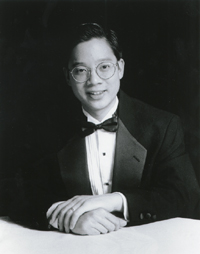Saturday, April 29, 2000
- 1999-2000 Season
- Symphony Orchestra
- Conductor: Jed Gaylin
- Works Performed:
- Symphony No. 1 in F Minor, Op. 10 by Dmitri Shostakovich
- Piano Concerto No. 1 in B-flat Minor, Op. 23 by Pyotr Ilyich Tchaikovsky
- Featured Artists: Jerry Wong
- Venue: Shriver Hall
- Time: 8:00 pm
Concert Details

Program Notes
“Russian Excursions”
Russian history during the 50 year span between Tchaikovsky’s Piano Concerto No. 1 in 1875 and Shostakovich’s First Symphony in 1925 is a rapid succession of titanic revolution. It’s worth a brief overview to put these two pieces in a larger historical context.
Sixty years of growing revolt were culminated in 1882 by the assassination of Alexander II. His successor, Alexander III, ruled during a time of extreme suppression. In 1894, Nicholas II of the Romanov Dynasty assumed czarist duties and by 1906 drew Russia into a humiliating defeat in the Russo-Japanese War. Revolutionary activity was growing headlong, and climaxed in a general strike by workers and the Revolution of 1905. Russia’s entrance into World War I resulted in massive casualties, causing vehement unrest. Shostakovich witnessed a great deal of the mass rioting in the Russian Revolution in 1917 that resulted in Nicholas II’s exile and execution. The ruling Dumas (parliament) created little peace, and in 1922 the Union of Soviet Socialist Republic was established under Lenin and the Bolsheviks. Such was the climate of Tchaikovsky’s death and Shostakovich’s birth.
Symphony No. 1 in F minor, Op. 10
Dmitri Shostakovich
Dmitri Shostakovich (1906-1975) was born in St. Petersburg and entered the Leningrad Conservatory in 1919. In addition to his development as a composer, he was originally to become a virtuoso pianist. Symphony No. 1 Op.10 was submitted to the Conservatory as his graduation exercise in 1925, receiving its premiere in 1926. The legendary Bruno Walter premiered it in Berlin a year later, and in the next several years, so did Stokowski (Philadelphia) and Toscanini (New York).
Shostakovich once stated that “There can be no music without ideology.” In the 1920’s Russia seemed to at last have a semblance of hope and direction. All kinds of bristling new avenues were being explored in musical Russia, and avant-garde theory was welcomed, but only as part of the composite canvas of the breathless and overwhelming socialist ideal. One can hear a youthful exuberance in this first symphony which reflects that idealism, but much deeper, there is also a terrible uneasiness. It is also the first glimpse of the powerful utterances that one associates with the composer’s music.
Shostakovich composed this work within a formal outline, with themes unifying the entirety of the piece; an introduction and theme and development in the first movement (Allegretto – Allegro non troppo), and the Allegro (moto perpetuo) serving as a scherzo, followed by a slow and broad Lento, completed by finale. One can find a host of influences in this early work, including Tchaikovsky. Yet already Shostakovich establishes his thumbprint in his maniacal driving rhythms and in his protracted, vast aural passages that march toward crushing climaxes.
Piano Concerto No. 1 in B-flat minor, Op. 23
Piotr Illyich Tchaikovsky
By 1866, Peter Illyich Tchaikovsky (1840-1893) had been awarded a professorship at the Moscow Conservatory which he held until 1877. During this time some of his most cherished works were composed, including Swan Lake, and the famous Piano Concerto No. 1 in 1875. The creation of the concerto was tumultuous, and yet with all the sweat and tears the work underwent, it has gone on to become a favorite in the repertoire.
Tchaikovsky was not a terrifically skilled pianist, and the solo writing is at times not extremely well thought out. This is no matter, because the entirety of the whole concerto sings of Tchaikovsky’s uncanny talent for lyricism and freshness. The opening alone to this wonderful piece, with its very memorable horn call and that soaring theme over pounding piano chords, is enough to forgive any shortcoming. Certainly, for much of the twentieth century, this piano concerto has been once of the most popular in the repertoire.
The first movement, Allegro non troppo e molto maestoso – Allegro con spirito, gives us the grand introduction, and then a theme which is interrupted by a second theme before the first is fully developed. This leads to a very ingenious double exposition. The first theme comes back in some dramatic moments, interspersed with theme number two and virtuosic shows in the solo piano. By 1875 Tchaikovsky was adept at the formal structures of composing (such as the sonata form), yet this movement is a somewhat unconventional blending of formality and creative craft.
The second movement, Andantino semplice – Prestissimo – Tempo I, is in song form and brings more of Tchaikovsky’s lyrical brilliance and cleverness. He allows us to languish in the darling, simple opening tune before the breezy prestissimo, a spirited French song which was once sung by Desiree Artot to whom Tchaikovsky was briefly engaged, “Il faut s’amuser, danser et rire.” The closing moments return us to the lovely opening, but there are many shades of the French tune mingled into the harmonization.
The finale Allegro con fuoco is set to balance the massive first and sighing middle movements and is in sonata form. Set like a rondo finale, it begins with a gregarious Ukrainian dance tune, ripe with syncopations. That melody is then modified in a virtuosic and searing piano flurry over which a flowing and serene tune drifts. These themes are developed thoroughly and then bow out for a maestoso tutti. The stage is then set for the true finale, quick paced and full of flourish, using the dance tune.
— Max Derrickson
